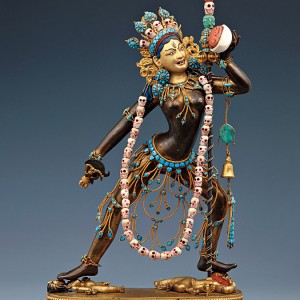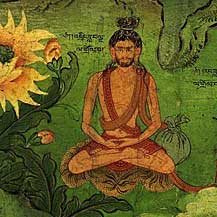Meaning of Tantra
8 Jul

Exquisite Statue of Vajrayogini
I have included here an explanation on tantra that I wrote as part of an article for the Indian Hirapur Yogini Temple on tsemrinpoche’s blog. I thought it was a neat little rough outline of the Tantric path. Rinpoche also gave us a profound explanation of Vajrayogini, the yidam and the preparation to receive tantra. In essence, yidam is a meditation deity practice that we either receive from our teacher or have a strong liking or affinity with. Rinpoche said that yidam means the deity practice that holds our mind from wrong perception and misconception of the self-grasping ‘I’ or just simply the the deity that holds us from the causes of suffering.
By tradition, we engage in preparatory practices to receive Tantric initiation and that includes Guru Yoga, prostrations, Mandala offerings, Vajrasattva and water offerings. The idea is to shore up merits in order to receive highest tantric initiation like Vajroyogini. The reason we need so much merits is because Vajrayogini’s practice is so potent that it has the potential to bring us to enlightenment within this lifetime itself. Vajrayogini’s mantra is the only mantra (Called the King of Mantras) because her mantra is the only mantra of the highest tantra to have the potential to grant spiritual attainments (enlightened qualities) with meditation.
Hence, we need tremendous amounts of merits and purification so that when we do receive the practice, we have a stable mind to practice and gain the powerful results of practice. Rinpoche says that we don’t wait till we get the initiation to practice, we can start now with a shrine to our intended yidam, protector, daily sadhana, keeping our promises, steadfast in our loyalty to our lama, increasing our knowledge of the Dharma (Lamrim, Wheel of Sharp Weapons and 50 Stanzas of Guru Devotion) and so forth. In the end, Rinpoche said that if anyone has any Dharma affinity and connection with Rinpoche, our yidam is Vajrayogini and that before receive her sacred practice, we should practice Manjushri intensely first. In maintaining humility, we do not reveal our yidam except to our fellow Dharma siblings. There is a short synopsis of the profound teaching that rinpoche gave.
 Tantra refers to the esoteric teachings and practices of Buddhism and Hinduism that were developed simultaneously around 500 CE. In the Buddhist tradition, the Sanskrit term “tantra” literally means “something stretched out”, like thread woven into a piece of fabric in a loom. This thread is “stretched out” to represent the everlasting mental continuum, which has no beginning and no end as we experience endless cycles of death and rebirth.
Tantra refers to the esoteric teachings and practices of Buddhism and Hinduism that were developed simultaneously around 500 CE. In the Buddhist tradition, the Sanskrit term “tantra” literally means “something stretched out”, like thread woven into a piece of fabric in a loom. This thread is “stretched out” to represent the everlasting mental continuum, which has no beginning and no end as we experience endless cycles of death and rebirth.
The practice of Tantra involves tapping into the everlasting continuity of the mind. It operates on three levels — the basis, the pathway and the result. On the level of basis, the everlasting continuity of the mind is at the subtlest level, which is known as the primordial clear light mind. This is our inherent nature that we take from lifetime to lifetime. The nature of this level of mind is clarity and awareness that is free from all conceptual thought or disturbing emotions, and it is what lies beneath all experiences whether we are awake or asleep. Therefore, no passing negative or positive experience, intensity of experience or rebirth can actually affect this clear light mind. Through the practice of Tantra, one taps into this subtlest mind as a basis for attaining enlightenment, which normally surfaces briefly through the bliss of sexual union and briefly at the moment of death as we enter into the bardo – the intermediate state between death and rebirth.
The second level of Tantra is the pathway and this refers to a specific method for attaining Buddhahood, namely the meditative practice of identifying ourselves as our personal Buddha or yidam. Hence, this special tantric method is called deity yoga. Such practices are normally conferred through an initiation ritual of the specific deity during which the lama plants the seeds of Bodhicitta and accomplishment of that deity into our mind-stream. From thereon, the initiate holds vows and is normally required to engage in a daily sadhana, which involves recitation, offerings, visualisations and mantra recitations in order to identify himself/herself as the deity. As a result, the practice of Tantra is sometimes called taking the “fruit”, which is enlightenment in the form of a Buddha-deity onto the “path”, which is our daily sadhana of self-identification as the Buddha-deity.
Finally, the third level of Tantra is the resultant path, which is to merge our mind-stream with the deity and thereby achieve enlightenment. Therefore in short, Tantra involves the practice of identifying ourselves as the Buddha-deity in order to purify our mind-stream of its stains and thereby achieve the basis, which is our primordial nature of clear light — Buddhahood.






No comments yet